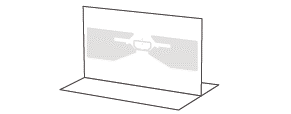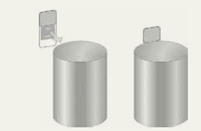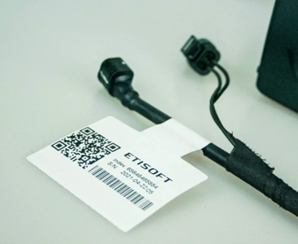
RFID solutions and metal surfaces
For many years one of the problems relating to the implementation of RFID technology was application of tags to metal surfaces. Typical RFID markings in the form of standard RFID labels after being applied to such surfaces no longer responded and became useless. Over time, however, solutions began to appear that allowed RFID technology to also enter these inaccessible areas.
Permanent tags
One of the first solutions were tags in the form of permanent tags in the form of reusable pieces made of hard plastic of various shapes and sizes. Such solutions are still commonly used, however, their relatively high cost per unit and, most frequently, no visual marking (text, bar code) should be kept in mind, which in the case of a possible reading problem makes it impossible to identify the product. It is, of course, possible to use another marking in the form of, for example, a standard label, but that entails additional costs and possible wrong pairing of a label with an RFID tag (two different values).

Nevertheless, where particular impact resistance is required, where unfavourable environmental conditions exist, or where adhesive solutions are not possible, this type of marking appears to be an ideal solution.
They are also indispensable when among customer demands there is the need to operate in high temperatures (up to even 300 degrees Celsius).
On-metal labels
In many cases customers accustomed to using self-adhesive labels search for RFID labels that operate smoothly after being applied to metal surface, the so-called on-metal labels.
Fortunately, the range of solutions of this type is increasing. We still do not have as much freedom here in terms of dimensions, surface materials of the type of adhesive used as in the case of standard labels, but the range of these solutions is increasing every day.
When deciding on this type of labels, it should be kept in mind that they are usually significantly thicker (1.2-2.2 mm) than the ones we commonly use, which entails the need to select a printer that will be able to easily print and encode them.
Flag or wrap-around labels
Another solution that makes it possible to use RFID technology are the so-called flag labels. There are different solutions where the most typical are labels that after encoding and printing require special folding and applying in such a way that the part containing an RFID tag protrudes from metal surface.

There are also special labels that do not have to be folded in a special way, however we need to apply them so that their dedicated part protrudes beyond the object which it has been applied to.

In the case of cables, wires and other elements of similar shapes, the so-called wrap-around labels can be a solution. The part of the label without a tag is applied around the product, whereas the other fragment containing an RFID tag remains at a distance from the product containing metal pieces.

Here, as in the case of the above-mentioned flag, we can design a label of nearly any shape, using virtually any material and adhesive selected to suit our application. Due to the fact that these labels are of standard thickness, we do not need to worry about the selection of a printer dedicated for thicker labels.
In each of the three cases mentioned above we have to accept the fact that part of the label must protrude from the surface to which it has been applied.
Summary
As you can see, nowadays there are many solutions on the market that allow for the use of RFID technology in the environment containing metal pieces. And although we still need to reckon with the so-called compromise accepting the limited number of dimensions, label thickness, or the need to use a label protruding from the product, we have to admit that RFID application on metal surfaces is no longer a problem.
Interested? Ask about best solutions!
